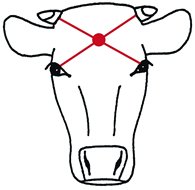The L214 organisation (vegan) released a new video in a calf slaughterhouse in the French Dordogne region with comments from Hugo Clément. We will analyze the arguments put forward with our slaughter expert.
Like with the Abattoir of Ales in South of France, some offenses are not linked to the way of slaughter but to the infrastructure of the slaughterhouse. The restaining equipement at the Ales slaughterhouse was not suitable for small cattle.
1.Calves are forcibly taken to a restraining box
On arrival at the slaughterhouse calves under 8 months of age are still frail on their legs and they are disoriented. Their handling is more difficult than for older cattle, this is due to the way of breeding.

They are not used to free movement. Sheep react to the group phenomenon and are therefore more easily manipulated. With the new animal welfare measures, it is forbidden to use an electric device to push them which makes the work of the herdsmen more restrictive.
One of the possible solutions is the use of conveyor belts (mobile conveyor), used in this slaughterhouse but after slaughter. Some slaughterhouses used a restrainer for restraining animals, but slaughter is more difficult for large calves. The use of a restrainer is also authorized for calves, provided that it is fitted with a chin strap at the end of the chain and that its operation allows the animal to be kept immobilized until loss of consciousness. (Decree of July 1, 2012 relating to the authorization of slaughter without stunning animals).

In the video we see a panicked calf trying to go through the front of the box, to avoid this we must raise the chinstrap up after each use and gradually lower it to let the head come out.
2 Calves see their fellows draining their blood
Two restain boxes were installed one next to the other, to increase the slaughter rate. Ritual slaughter is very slow since immobilization times in the box are imposed after the bleeding (45s inside the box and 45s outside). from a ritual point of view, it is forbidden to slaughter an animal in front of his fellow, it would have been necessary to proceed by alternation, conventional slaughter then ritual slaughter or vice versa. This would avoid the mixture of offal and slaughter.
In the video we do not see blood from the second calf but only slaughtered, moreover the we see the back of box. The bleeding for « stunned » calves is done further in the chain.
3. Halal slaughter
As for the halal slaughter, we see that the slaughterhouse respects the rules if a calf regains consciousness it is immediately stun. Calves are bled upright. The rule imposes resraining, moreover the fact of turning it upside downon on its back is already very additional stress.To make it easier for the slaughterman and to do a good cut put it on the back is bettter. Temple Grandin (American expert) suggests that the box does not twist the animal’s neck too much (Head holding devices should be designed to avoid excessive bending of the neck).
4.Kosher slaughter
Rabbis use very special knives dedicated to slaughter and attach great importance to sharpening. The saw movement of the rabbi is due to the knife used with a small handle more difficult to do a one cut. It also comes from the fact that the calf’s skin is not stretched by the box, perhaps its two points should be reviewed.
Temple Grandin enphasis on this point a quick incision means less suffering (A swift cut is best, slow cutting is more likely to prolong sensibility)
5.Stunning Calves show signs of regaining consciousness
Animals must be subjected to a consciousness test before being hooked (Spontaneous blinking is considered as an indicator of consciousness (Grandin, 2013). For total loss of consciousness a distinction must be made between pedaling movements and uncoordinated muscle contractions that last about three to four minutes they are not related to the animal’s suffering because they are reflex movements.
For the air pistol stun, we see that the operator does not use the chin strap to immobilize the head, so he misses the target at the top of the head

Supported by a scientific committee ( with members of INRA), the local meat division has just developed a prototype which should allow animals to be stunned provoking as little stress as possible.













Discussion about this post